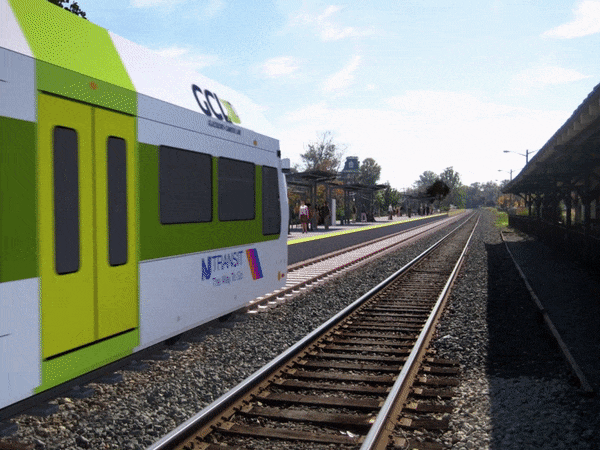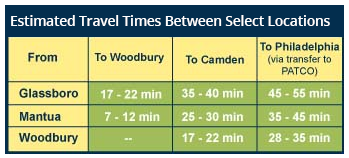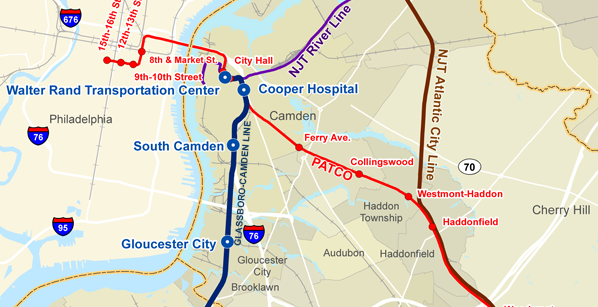FAQs

- General Project
- Route Selection
- Train Service
- Train Information
- Train Stations
- Train Tracks
- Environmental Impact Statement
- Preliminary Engineering Design
General Project
- What is the Glassboro-Camden Line (GCL)?
The Glassboro-Camden Line (GCL) is a proposed 18-mile passenger rail line between Glassboro and Camden in Southern New Jersey. The GCL restores passenger rail service along an existing rail line traversing Gloucester and Camden counties including the communities of Glassboro, Pitman, Sewell, Mantua Township, Deptford Township, Wenonah, Woodbury Heights, Woodbury, Westville, Brooklawn, Gloucester City, and Camden. - What is the purpose and need for the GCL?
The purpose of the GCL is to improve transit service along the Glassboro to Camden corridor with a focus on increasing mobility and improving links between the established communities, jobs, and activity centers.
The following goals were derived from the needs of the communities along the corridor and Southern New Jersey as a whole, as articulated during the public outreach and analyses performed during the Alternatives Analysis study:- Provide more transit choices and improved quality of service
- Develop a transit network that improves links between people and activity centers
- Reduce Reducing highway congestion with competitive transit investment
- Maximize existing transportation assets and minimize impacts to the environment
- Support state and local planned growth initiatives
- Promote economic development and improve quality of life
- Where is the Glassboro-Camden Line (GCL) corridor?
The 18-mile corridor stretches from Glassboro to Camden along the existing railroad right-of-way currently used by Conrail for freight service. The restoration of rail passenger service using light rail technology was the alternative preferred by the local communities and selected at the end of the Southern New Jersey to Philadelphia Mass Transit Expansion Alternatives Analysis study. - What is light rail technology?
Light rail technology refers to trains that are smaller and quieter than conventional commuter rail trains such as the Speedline operated by PATCO, the Atlantic City Line operated by NJ TRANSIT, the Regional Rail system operated by SEPTA, and the Northeast Regional rail operated by Amtrak. The type of trains anticipated to be used on the GCL corridor will be similar to those used on the NJ TRANSIT River LINE. Key characteristics of light rail include level boarding and the ability to operate on both a railroad right-of-way and an in-street alignment. - What is the role of each agency on the GCL Project Team?
- NJ TRANSIT – Project Partner
- South Jersey Transportation Authority (SJTA) – Project/Funding Partner
- Delaware River Port Authority (DRPA) – Project Manager
- Who will operate the new commuter rail line?
At this time, a determination has not been made on the operator for the GCL. - How much will the line cost to build?
Approximately $1.6 to $1.8 billion will be needed to implement the project. - When will trains begin running?
The GCL will begin carrying passengers as soon as preliminary engineering design, pre-construction activities, and construction are completed which will take approximately 6 years.
Route Selection
The selected 18-mile corridor stretches from Glassboro to Camden along the existing railroad right-of-way currently used by Conrail for freight service. The restoration of passenger rail service using light rail technology was the alternative preferred by the local communities and selected at the end of the Southern New Jersey to Philadelphia Mass Transit Expansion Alternatives Analysis (AA) study. This comprehensive 2-year study was conducted by STV Incorporated, a nationally-recognized transit planning and engineering firm.
- How was the GCL route selected?
The GCL route via Conrail Right-of-Way was selected based on the following reasons:- Highest new transit trip potential
- Lowest capital cost
- Lowest operating cost
- Maximizes use of existing Conrail infrastructure
- Links communities, universities, activity centers and cities
- Supports intra‐NJ trips
- Encourages economic redevelopment and TOD within surrounding communities
- Creates footprint consistent with surrounding area
- Supported by local and state elected officials and Office of Smart Growth
- Received the most public comment support
Train Service
- What are the estimated travel times between stations?
The following table shows estimated travel times between select locations.
- How often will the trains operate?
Trains are planned to operate every 15 minutes in each direction through the day and early evening, with longer headways (30 minutes) in the late evening. A train in each direction every 15 minutes means that – on average – a train will pass by any point on the corridor every 7.5 minutes. The exact interval between trains at any specific point along the line cannot be determined until a final schedule is prepared prior to the line being placed in operation. - Will I be able to take the GCL to Center City Philadelphia? Atlantic City? Other places?
Yes, GCL travelers would be able to make rail transfers at Walter Rand Transportation Center (WRTC) in Camden to reach local and long distance destinations.- Transfer to PATCO:
- Connection to Center City Philadelphia.
- Connection to SEPTA Market-Frankford Line, Broad Street Line, Trolley and Regional Rail Lines.
- Connection to 30th Street Station and AMTRAK routes.
- Connection to SEPTA Market-Frankford Line, Broad Street Line, Trolley and Regional Rail Lines.
- Connection to communities within Camden County.
- Connection to Lindenwold
- Connection to Atlantic City via NJTRANSIT Atlantic City Line.
- Connection to Center City Philadelphia.
- Transfer to NJTRANSIT River Line:
- Connection to Trenton and New York City via the Northeast Corridor.
- Transfer to multiple NJTRANSIT bus lines.
- Transfer to PATCO:
- How many people will ride the new line?
The Light Rail Alternative is estimated to carry 16,000 riders daily by 2040. A large portion of these represent new transit trips: trips that would otherwise be made by car.
Train Information
- What type of train will be used for the GCL?
The GCL technology would be similar to the technology used on the NJ TRANSIT River LINE, which is a light rail vehicle that generates its own electric power via an on-board diesel engine.
Train Stations
- What will the stations look like?
Station types will vary between small, walk-up stations in the center of existing communities and larger, park-and-ride facilities built near major roadways. During the EIS phase, the GCL Project Team worked with each community in planning the configurations of stations. To view the station layouts, click here.
Train Tracks
- How will traffic be affected in my town? Will gate crossings cause traffic jams?
A traffic analysis determined that the 2 car trains that the GCL will use will take a short period of time to travel through an intersection, typically less than the duration of a red light.
Environmental Impact Statement
- What is an Environmental Impact Statement?
The Environmental Impact Statement (EIS) is a formal document that records the potential social, economic, and environmental benefits and impacts of the proposed project, and proposes measures to mitigate any adverse impacts. The Project Team is preparing an EIS for the GCL project following the guidelines for the preparation of an EIS as required under New Jersey Executive Order No. 215. - How was the EIS funded?
NJ TRANSIT is providing the funding for the environmental study. - Where can I view a copy of the EIS?
The Final Environmental Impact Statement (FEIS) is available on our resources page. As an added convenience, printed hard copies of the FEIS were provided to municipal buildings and public libraries for public viewing. Locations include:- Gloucester City Hall, 512 Monmouth Street, Gloucester City, NJ 08030
- Gloucester City Library, 50 N Railroad Avenue, Gloucester City, NJ 08030
- Brooklawn Borough Municipal Building, 301 Christiana Street, Brooklawn, NJ 08030
- Westville Borough Municipal Building, 165 Broadway, Westville, NJ 08093
- West Deptford Township Municipal Building, 400 Crown Point Road, West Deptford, NJ 08086
- West Deptford Library, 420 Crown Point Road, Thorofare, NJ 08086
- Woodbury Library, 33 Delaware Street, Woodbury, NJ 08096
- Woodbury Heights Borough Municipal Building, 500 Elm Avenue, Woodbury Heights, NJ 08097
- Mantua Township Municipal Building, 401 Main Street, NJ 08051
- Pitman Borough Municipal Building, 110 South Broadway, Pitman, NJ 08071
- McCowan Memorial Library, 15 Pitman Avenue, Pitman, NJ 08071
- Glassboro Borough Municipal Building, 1 S Main Street, Glassboro, NJ 08028
- Glassboro Library, 2 Center Street, Glassboro, NJ 08028
- Wenonah Borough Municipal Building, 1 S West Avenue, Wenonah, NJ 08090
- Wenonah Free Public Library, 101 E Mantua Avenue, Wenonah, NJ 08090
- Deptford Township Municipal Building, 1011 Cooper Street, Deptford, NJ 08096
- Gloucester County Administration Building, 2 South Broad Street, Woodbury, NJ 08096
Preliminary Engineering Design
- When does the Preliminary Engineering Design and Project Management phase start?
In February 2021, the GCL Project Team completed the project’s Environmental Impact Statement (EIS) phase enabling it to advance to the Preliminary Engineering Design and Project Management phase. The next step will be issuing a request for proposal (RFP) for the preliminary engineering design phase in the coming months. - How is the Preliminary Engineering Design and Project Management phase being funded?
South Jersey Transportation Authority (SJTA) has committed $200 million towards the Preliminary Engineering Design and Project Management Phase. The funding allocation is for preliminary engineering design, program management, right-of-way titles and easements, and geotechnical survey/utility relocations on the project.
Do you have a question you would like to see answered here?
We are continually adding FAQs to our website, so please check back often. If you have a question you would like to see answered here, please let the GCL Project Team know by clicking here.


Let's stay connected!
Follow us across social media for the latest GCL news, project updates, and more.